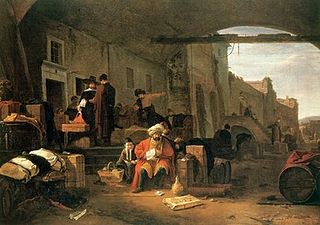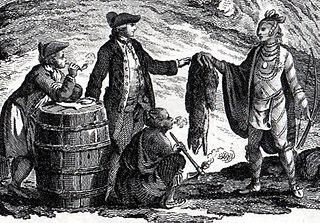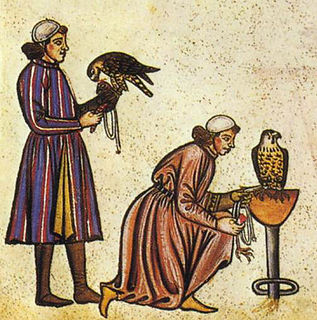Related Research Articles

The Hudson's Bay Company is a historically Anglo-Canadian but now American-owned retail business group. A fur trading business for much of its existence, HBC now owns and operates retail stores in Canada and the United States. The company's namesake business division is Hudson's Bay, commonly referred to as The Bay.

A merchant is a person who trades in commodities produced by other people, especially one who trades with foreign countries. Historically, a merchant is anyone who is involved in business or trade. Merchants have operated for as long as industry, commerce, and trade have existed. In 16th-century Europe, two different terms for merchants emerged: meerseniers referred to local traders and koopman referred to merchants who operated on a global stage, importing and exporting goods over vast distances and offering added-value services such as credit and finance.

A quill is a writing tool made from a moulted flight feather of a large bird. Quills were used for writing with ink before the invention of the dip pen, the metal-nibbed pen, the fountain pen, and, eventually, the ballpoint pen.

Swans are birds of the family Anatidae within the genus Cygnus. The swans' closest relatives include the geese and ducks. Swans are grouped with the closely related geese in the subfamily Anserinae where they form the tribe Cygnini. Sometimes, they are considered a distinct subfamily, Cygninae. There are six living and many extinct species of swan; in addition, there is a species known as the coscoroba swan which is no longer considered one of the true swans. Swans usually mate for life, although "divorce" sometimes occurs, particularly following nesting failure, and if a mate dies, the remaining swan will take up with another. The number of eggs in each clutch ranges from three to eight.

Rupert's Land, or Prince Rupert's Land, was a territory in British North America comprising the Hudson Bay drainage basin, a territory in which a commercial monopoly was operated by the Hudson's Bay Company for 200 years from 1670 to 1870. It was named after Prince Rupert of the Rhine, a nephew of Charles I and the first Governor of the Hudson's Bay Company (HBC). In December 1821, the HBC monopoly was extended from Rupert's Land to the Pacific coast.

The greylag goose or graylag goose is a species of large goose in the waterfowl family Anatidae and the type species of the genus Anser. It has mottled and barred grey and white plumage and an orange beak and pink legs. A large bird, it measures between 74 and 91 centimetres in length, with an average weight of 3.3 kilograms. Its distribution is widespread, with birds from the north of its range in Europe and Asia migrating southwards to spend the winter in warmer places. It is the type species of the genus Anser and is the ancestor of most breeds of domestic goose, having been domesticated at least as early as 1360 BC. The genus name is from anser, the Latin for "goose".

The snow goose is a species of goose native to North America. Both white and dark morphs exist, the latter often known as blue goose. Its name derives from the typically white plumage. The species was previously placed in the genus Chen, but is now typically included in the "gray goose" genus Anser.

The Canada goose, or Canadian goose, is a large wild goose with a black head and neck, white cheeks, white under its chin, and a brown body. It is native to the arctic and temperate regions of North America, and it is occasionally found during migration across the Atlantic in northern Europe. It has been introduced to the United Kingdom, Ireland, Finland, Sweden, Denmark, New Zealand, Japan, Chile, Argentina, and the Falkland Islands. Like most geese, the Canada goose is primarily herbivorous and normally migratory; often found on or close to fresh water, the Canada goose is also common in brackish marshes, estuaries, and lagoons.

A dip pen or nib pen or pen nib usually consists of a metal nib with capillary channels like those of fountain pen nibs, mounted in a handle or holder, often made of wood. Other materials can be used for the holder, including bone, metal and plastic; some pens are made entirely of glass.

The fur trade is a worldwide industry dealing in the acquisition and sale of animal fur. Since the establishment of a world fur market in the early modern period, furs of boreal, polar and cold temperate mammalian animals have been the most valued. Historically the trade stimulated the exploration and colonization of Siberia, northern North America, and the South Shetland and South Sandwich Islands.

The trumpeter swan is a species of swan found in North America. The heaviest living bird native to North America, it is also the largest extant species of waterfowl, with a wingspan of 185 to 250 cm. It is the American counterpart and a close relative of the whooper swan of Eurasia, and even has been considered the same species by some authorities. By 1933, fewer than 70 wild trumpeters were known to exist, and extinction seemed imminent, until aerial surveys discovered a Pacific population of several thousand trumpeters around Alaska's Copper River. Careful reintroductions by wildlife agencies and the Trumpeter Swan Society gradually restored the North American wild population to over 46,000 birds by 2010.
The Birmingham pen trade evolved in the Birmingham Jewellery Quarter and its surrounding area in the 19th century; for many years, the city was the centre of the world's pen trade, with most dip pens being produced there. At the height of the Jewellery Quarter's operations, there were about 100 pen factories, which employed around 8,000 skilled craftspeople.

A slave market is a place where slaves are bought and sold. These markets became a key phenomenon in the history of slavery.
The Saāwithiniwak or Woodland Cree, are a Cree people, calling themselves Nîhithaw in their own dialect of the language. They are the largest indigenous group in northern Alberta and are an Algonquian people. Prior to the 18th century, their territory extended west of Hudson Bay, as far north as Churchill. Although in western Northern Saskatchewan and Manitoba, by the 18th century, they acted as middlemen in trade with western tribes. After acquiring guns through trade, they greatly expanded their territory and drove other tribes further west and north.

The Hudson Bay expedition was a series of military raids on the fur trading outposts and fortifications of the British Hudson's Bay Company on the shores of Hudson Bay by a French Royal Navy squadron under the command of the Comte de Lapérouse. Setting sail from Cap-Français, Saint-Domingue in 1782, the expedition was part of a series of globe-spanning naval conflicts between France and Great Britain during the American Revolutionary War.

The mute swan is a species of swan and a member of the waterfowl family Anatidae. It is native to much of Eurosiberia, and the far north of Africa. It is an introduced species in North America, home to the largest populations outside of its native range, with additional smaller introductions in Australasia and southern Africa. The name 'mute' derives from it being less vocal than other swan species. Measuring 125 to 170 cm in length, this large swan is wholly white in plumage with an orange beak bordered with black. It is recognizable by its pronounced knob atop the beak, which is larger in males.

The North American fur trade refers to the commercial trade in furs in North America. Various indigenous people of the Americas traded furs with other tribes during the pre-Columbian era. Europeans started their participation in the North American fur trade from the initial period of their colonization of the Americas onward, extending the trade's reach to Europe. European merchants from France, England and the Dutch Republic established trading posts and forts in various regions of North America to conduct the trade with local indigenous tribes. The trade reached the peak of its economic importance in the 19th century, by which time it relied upon elaborately developed trade networks.

The maritime fur trade was a ship-based fur trade system that focused on acquiring furs of sea otters and other animals from the indigenous peoples of the Pacific Northwest Coast and natives of Alaska. The furs were mostly sold in China in exchange for tea, silks, porcelain, and other Chinese goods, which were then sold in Europe and the United States. The maritime fur trade was pioneered by Russians, working east from Kamchatka along the Aleutian Islands to the southern coast of Alaska. British and Americans entered during the 1780s, focusing on what is now the coast of British Columbia. The trade boomed around the beginning of the 19th century. A long period of decline began in the 1810s. As the sea otter population was depleted, the maritime fur trade diversified and transformed, tapping new markets and commodities, while continuing to focus on the Northwest Coast and China. It lasted until the middle to late 19th century.

Human uses of birds have, for thousands of years, included both economic uses such as food, and symbolic uses such as art, music, and religion.

MS Europic Ferry was a roll-on/roll-off car ferry built in 1967 by Swan Hunter for the Atlantic Steam Navigation Company (ASN). She was acquired by European Ferries in 1971 when they took over the ASN and served with them under the Townsend Thoresen branding. The Europic Ferry was requisitioned by the British government in April 1982 and transported stores, equipment and troops to the South Atlantic during the Falklands War. After the war she returned to service with European Ferries until that company was sold to P&O in 1987. She was sold again to Namora Shipping in 1993 and served on routes in the Mediterranean until sold for scrapping in 2004.
References
- 1 2 Houston, C. S., Ball, T. F., & Houston, M. (2003). Appendix E: The nineteenth-century trade in swan skins and quills. In Eighteenth-century naturalists of Hudson Bay. Montreal, Que: McGill-Queen's University Press.
- ↑ MacDowell, L. S. (2012). The Swan Trade. In An environmental history of Canada. pp. 34. Vancouver: UBC Press.